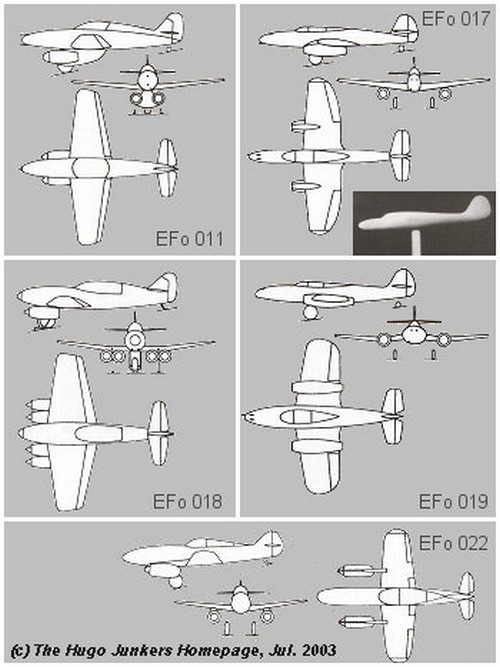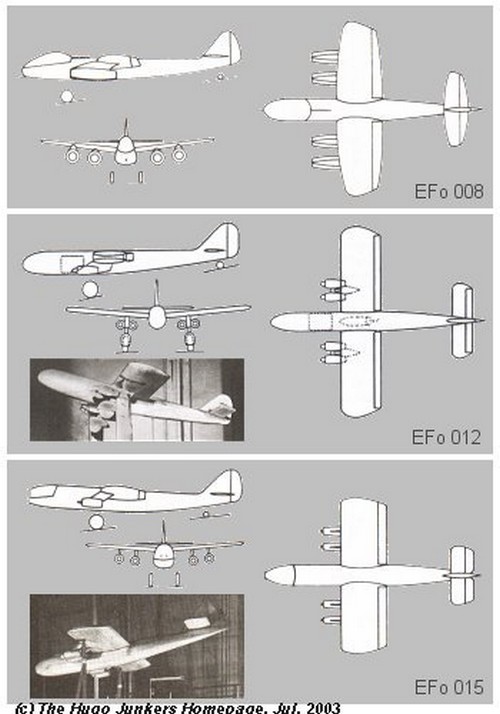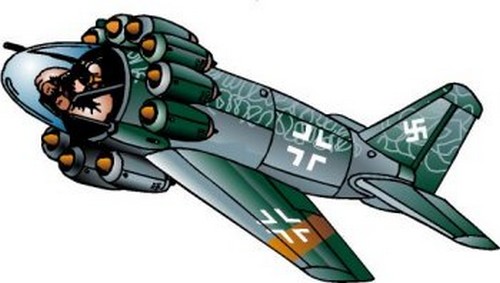Junkers EFo 001 - EFo 020
see also: Junkers EF009 Model Kits
Experimental Jet Aircraft Studies
Windchannel Test Models
Junkers EFo Jet Fighters

Junkers started the developement of a jet engine design in 1936 at its Magdeburg facilities. At the same time in Dessau several developement studies were performed, regarding the correct design of jet aircraft. One developement group concentrated on the design of high speed fighter aircraft, while the other was focused on the design of combat and bomber aircraft.
Each of these studying designs got an own project designator, starting with EFo and following a sequentiell number. The final known EFo designator was the EFo019, so that about 19 to a maximum of 20 designs might have been projected and tested in the Dessau windchannels between 1935 and 1939/40. Designs EFo 001 to EFo 008 are not public known today. It might be, that these designs were more of general purpose and not exactly dedicated to the Fighter or the Bomber design. Three basic designs were produced:
EFo010 - two jet engines under wing, record aircraft design
EFo011 - two jet engines under fuselage
EFo017 - two jet engines under wing
EFo018 - four engines under wing
EFo019 - two jet engines integrated in wing
EFo022 - as EFo018, designed as record aircraft
The initial studies were concentrated on a jet fighter and record aircraft design, as the new jet engines allowed higher speed maximums than the classic piston engines. All fighter and record aircraft designs were cantilever monoplane designs with retractable undercarriage. They mostly differ in the way of the engine mounting.
A major lack of all of these designs was the small operating time. A flight time of 6 minutes or a range of less than 100 kilometers, like the EFo018, was not adaquate for a typical fighter mission, but just useable for object defense missions. Even 15 to 30 minutes just offer a range of maximum 400 kilometers and was not enough for the later air combats with hundreds of enemy bombers over Germany. All of these early Junkers fighter designs were more in the area of the later Messerschmitt Me163 than of the early jet fighter of Heinkel and Messerschmitt Me262.
Technical Data:
| Aircraft | year | engine | length
in m | span
in m | wing area
im sqm | net weight
in kg | payload
in kg | seats | speed
in km/h | range
in km |
| EF010
EF011
EF022 | 1935
1936
1938 | 2 x jet engines
2 x jet engines
2 x jet engines | n.a.
n.a.
6,15 | n.a.
n.a.
5,20 | n.a.
n.a.
n.a. | n.a.
n.a.
T/O | n.a.
n.a.
1300 | 1 | 830
830
920 | n.a.
15 min.
15 min. |
| EF017
EF018
EF019 | 1939
1939
1939 | 2 x jet engines
2 x 2 jet engines
2 jet engines | 10,40
n.a.
9,50 | 10,20
n.a.
9,50 | n.a.
n.a.
n.a. | n.a.
T/O
T/O | n.a.
3500
3700 | 1 | 830
950
850 | 30 min.
6 min.
30 min. |
Weblinks:
Junkers EFo Jet Bomber Studies

EFo008 - four jet engines under wing, high altitude bomber
EFo012 - two jet engine pairs under wing (1939)
EFo015 - similar to EFo008, modified nose section
The second approach headed for a high speed bomber design, which could also be used for high altitude missions. These designs were highlever monoplanes with four jet engines and two seats.
The initial design of the EFo 008 was a high altitude bomber, which should be operated at an altitude of about 6500 meters with a speed of 810 km/h. The maximum altitude was designed for 12000 meters, which was not reachable by any prop aircraft at this time. The cabin was pressurized. The range of 660 kilometers was very short and therefore this aircraft just could have been used in the near of the front lines. However, this was the strategy of Luftwaffe in the second half of the thirties.
The EFo 012 was designed in 1939. This aircraft is again a high altitude bomber. The speed was increased on this design to about 750km/h and the range was extended to 1100 kilometers. For aircraft defense two remote controlled machine guns were installed.
The final known bomber study was the EFo 015. This design returned to the classic EFo 08 design with the improved data of the EFo 12. At the mission altitude of 6000 meters this aircraft was able to reach an operating speed of 770 km/h. The range was designed for 1200 kilometers. Two fixed machine guns were installed in the nose section.
Technical Data:
| Aircraft | year | engine | length
in m | span
in m | wing area
im sqm | net weight
in kg | payload
in kg | seats | speed
in km/h | range
in km |
| EF008 | 1936 | 4 x jet engines | 13,75 | 10,50 | n.a. | n.a. | n.a. | 2 | 850 | 660 |
| EF012
EF015 | 1939
n.a. | 4 x jet engines | n.a.
12,70 | 15,50
9,40 | n.a.
n.a. | n.a.
T/O | n.a.
6000 | 1 | 750
800 | 1100
1200 |
Junkers Jet Object Defense Fighter

Junkers EFo 009 Design Study
(c) German Vertical Take Off Aircraft
Two principle design studies are known as object defense fighters. These aircraft had small ranges but high speeds and climb performance:
EFo009 - 10 Argus engines around the fuselage
EFo018 - 2 jet engine pairs under wing, center landing gear
The EF009 was a fighter aircraft with four jet engines under the fuselage plus additional six pulsojet engines in front of the nose section. It was a vertical take off aircraft, which started from a ramp. Probably the pulsojet engines were used for a maximum climb rate, while the jet engines were used in horizontal flight.
The pilot was laying in the aircraft. The aircraft had only a few minutes of flying time. The EFo 009 was able to reach about 850 km/h and a climb rate of 77 meters per second. The landing was performed on skies. It was especially designed for short defense missions of local objects.
The EF018 had 2 x two tandem jet engines also under wing A special feature was the single main wheel undercarriage under the fuselage. The EF018 was a special mission aircraft for short defense flights of up to 6 minutes. However it is unclear, if this aircraft was a failed design of the fighter developement group due to its short range or if it was originally designed as an object defense aircraft.
Technical Data:
| Aircraft | year | engine | length
in m | span
in m | wing area
im sqm | net weight
in kg | payload
in kg | seats | speed
in km/h | range
in km |
| EF009
EF018 | n.a.
1939 | 4 x jet + 6 x pulsojet engines
2 x 2 jet engines | 5,00
n.a. | 4,00
n.a. | n.a.
n.a. | T/O
T/O | 2000
3500 | 1
1 | 950
950 | n.a.
6 min. |
Weblinks:
introduced Jul 1996, transfered Aug 2017
http://hugojunkers.bplaced.net/
contents last updated 25 Jul 2003




